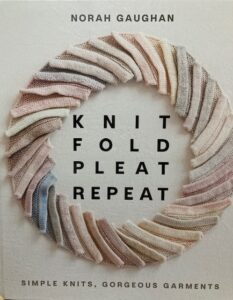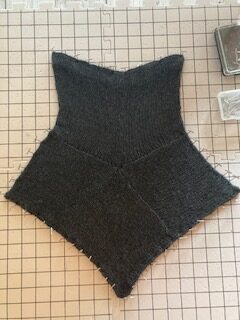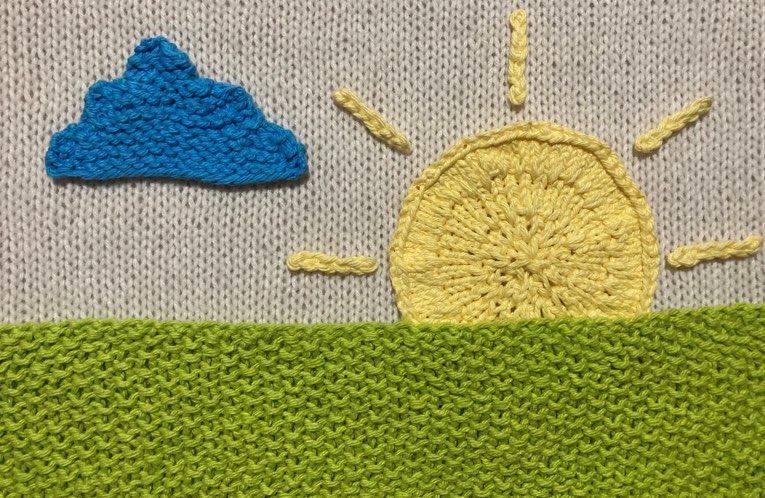BOOK REVIEW “Knit Fold Pleat Repeat” by Norah Gaughan

Price (at time of review): $29.99 – on sale for $23.86 or 20% off (on Knit Picks), Amazon (hardcover): $37.99
Text Copyright 2022 Norah Gaughan
Photographs Copyright 2022 Caroline Goddard
Abrams Books
224 pages, 36 patterns, plus variations
I haven’t purchased any knitting books in years so when a friend gave me some money for my birthday, I decided to treat myself. I didn’t know about this book before I saw it on Knit Picks but it looked fascinating (and it was on sale!) so I decided to give it whirl. Now to review it – and try not to make it sound like a high school book report lol.
Chapter 1: Concepts
This chapter is an outline of the rest of the chapters and general philosophies. Each chapter starts out with simpler concepts and patterns and moves on to more complex designs. Then each chapter builds on concepts from the previous chapter and adds other elements. This is a really nice touch.
All of the patterns are followed by a “Design Your Own” section, which I will discuss later.
Chapter 2: Square Up
This chapter starts with a square kerchief. It is knit like an oversized version of a dishcloth pattern, which many knitters already know, making it a great place to start. I love that she’s incorporated this design because it’s simple and it’s a great way to get your mind wrapped around what can be done with simple shapes.

There are eight patterns in this chapter and I love how the author describes her design process. She also explains how to make variations and changes. She keeps it simple by using squares and rectangles but adds stitch combinations which make it look much more complicated. The photographs are lovely and help show the important elements of the knitted items.
I knit the pattern in this chapter named “Trio” (see picture) . It was super easy and I added my own edging that wasn’t in the pattern. My only complaint is there’s no schematic showing how to attach the pieces (this way of attaching pieces is common in some shawls and because of this it may seem obvious to some people but I’m sure there are others who would appreciate a schematic nonetheless).
Chapter 3: Manipulate
This chapter is all about manipulating knitted fabric. The author does a great job here of explaining her design process. I really love how she has made the knitted pieces with “guides” knit right into them to show you where you are to fold, smock, cinch or gather the work. This makes it unnecessary to do any measuring afterward to figure out where to sew. I love, love, love this. Using stitches to make it obvious where the sewing takes place, makes things so easy for the knitter, but makes the finished pieces look super complicated.
There are seven patterns in this chapter and I would like to knit most of them.
Chapter 4: Multiply
In this chapter things start to get a little more complicated, but at the same time are kept easy because everything is still knit in basic shapes (squares, rectangles). The difference here is how these shapes are fit together.
The author still does a great job of making the end piece come together in the simplest way possible, with minimal sewing. In most cases, she knits items in one piece by picking up stitches as she goes to avoid sewing together pieces at the end. This is my favourite way to knit. I love working complex designs as I go. I usually dislike piecing things together at the end, although in some cases this is necessary or is the best way to get the design outcome you’re looking for.
There are seven patterns in this chapter and once again I want to knit most of them, not just because they are beautiful but because they contain great lessons for knitting shapes. I attempted to knit one of the patterns in this chapter but I ran into an issue…”LT” and “RT”. She refers to how using a twisted stitch easily creates lines but I can’t find any reference to how to make this twisted stitch and I’m assuming that “LT” stands for Left Twist and “RT” stands for Right Twist but again I see no reference to this. There are charts but they don’t show how to make these twists and they also only say “LT” and “RT”. There is a section in the back for abbreviations and special techniques but neither of these are included in those sections. I know I can look up these techniques online but it would be better if they were included in the book with the patterns that use them.
Chapter 5: Hone
This chapter again gets a little more complicated but overall is kept easy (I know that doesn’t make sense, but it’s true). She uses simple shapes and fits them together in unique ways, allowing the item to change shape when draping over the body. It’s amazing how the simplest and “squarest” of shapes can make such flowing designs – designs which in the end don’t look square at all.
In this chapter (and in previous chapters) she discusses the different tools she uses to create models of what she wants the finished item to look like. In one design she shows how she used paper and it brings to mind how many patterns in this book are reminiscent of origami (which I love by the way).
There are seven patterns in this chapter and again I want to knit most of them. The knitting itself looks so plain and easy to knit but when the garment is worn it looks so different than you would expect. Instead, it looks like you did some kind of knitting gymnastics to make the item fit as it does. Amazing and inspirational, she explains even more her design process and gives great tips and examples of her design process.
In this chapter she takes rectangles and folds them to look like sweaters and tops you may have seen made out of non-knitted fabric. While previous chapters include patterns including headbands, pillows, skirts, tops etc. this chapter is devoted to tops.
There are seven patterns in this chapter and they all have one thing in common – a focal point. Each top is very simple with the exception of a fold or pleats or scrunching that create a beautiful focal point for each. In some tops the focal point is the neckline, in others the sleeves, etc. just depending on how she decided to place the folds. She speaks specifically about origami in this chapter and how useful paper folding is to coming up with designs – and now that’s something I’m going to have to try.
This chapter is the last one in the book and I think it’s a great way to end things. All the ideas in the book seem to culminate in this final chapter.
Pros: The book is well written. The photographs are lovely and help show the important elements of the knitted items. The book and photographs give me a great deal of inspiration for my own design process. Listening to another designer describe how she came up with her patterns is a lot of fun. Many of the patterns in this book are simple enough for beginner knitters, but look far more advanced which I also think is fun.
Cons: There are patterns with techniques I couldn’t find the instructions for in the book, as I mentioned earlier. Also, as I was reading the book, I kept thinking about my yarn stash and despairing that I didn’t have the “right yarn” on hand to knit several of the designs. Yes, one of the cons is that I want to knit almost every pattern and I don’t have the time or the yarn to do it. 😊
Take away: I would recommend this book to any knitter, but especially to knitters who also like to make their own designs.
If you want some inspiration, check out the book but no matter what remember to
Stick to the Knitting😊

